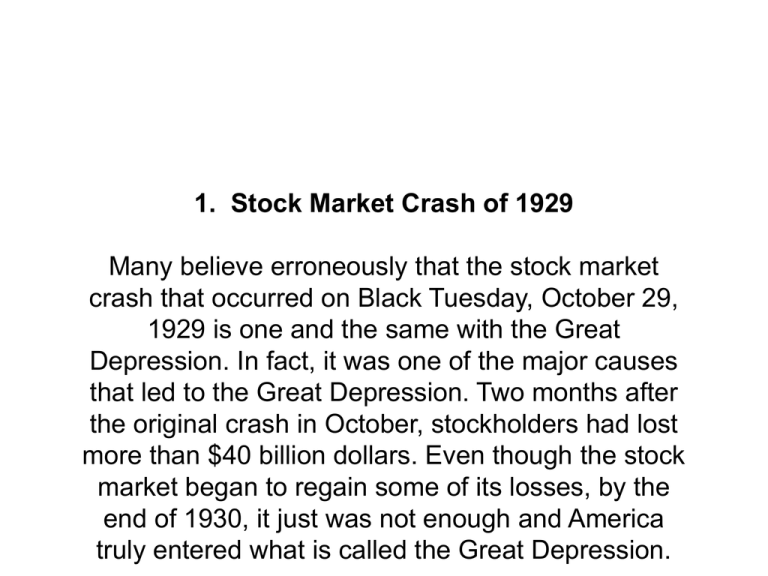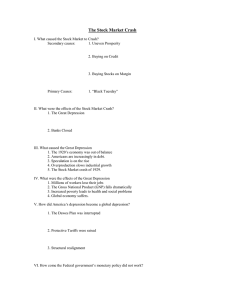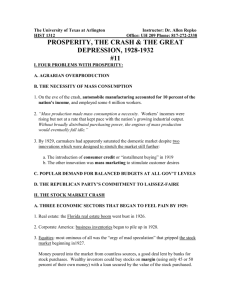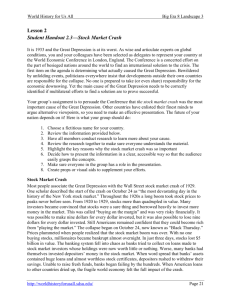1. Stock Market Crash of 1929
advertisement

1. Stock Market Crash of 1929 Many believe erroneously that the stock market crash that occurred on Black Tuesday, October 29, 1929 is one and the same with the Great Depression. In fact, it was one of the major causes that led to the Great Depression. Two months after the original crash in October, stockholders had lost more than $40 billion dollars. Even though the stock market began to regain some of its losses, by the end of 1930, it just was not enough and America truly entered what is called the Great Depression. 2. Bank Failures Throughout the 1930s over 9,000 banks failed. Bank deposits were uninsured and thus as banks failed people simply lost their savings. Surviving banks, unsure of the economic situation and concerned for their own survival, stopped being as willing to create new loans. This exacerbated the situation leading to less and less spending. 3. Reduction in Purchasing Across the Board With the stock market crash and the fears of further economic problems, individuals from all classes stopped purchasing items. This then led to a reduction in the number of items produced and thus a reduction in the workforce. As people lost their jobs, they were unable to keep up with paying for items they had bought through installment plans* (debt) and their items were repossessed. More and more inventory of goods produced began to accumulate (overproduction). The unemployment rate rose above 25% which meant, of course, even less spending to help alleviate the economic situation. Overproduction Between 1923 and 1929 worker output of manufactured goods increased by 32 percent. Assembly lines and new machinery boosted production. As manufacturers saw it, the more goods produced and sold, the more profit there was to be had. There were limits on how much Americans would or could buy; there were only so many kitchen appliances or cars a person needed. (especially when they began being unemployed in droves…) Buying slowed down, as we read in last slide reduction of purchasing. By 1929 the stores had built up huge inventories of goods and stopped ordering from factories. Manufacturers had overproduced, and they had to begin cutting back. Factories began laying off substantial numbers of workers, even before the stock market crash. When the crash came, many more people lost not only their jobs but their savings, too. The growing number of unemployed people bought only bare necessities. Goods sat on shelves in warehouses and stores. Federal Reserve Mistakes Federal Reserve, created in 1913, issues Federal Reserve Notes, which create the paper money supply. Basically, they set the interest rates, indirectly, because it loans money to commercial banks. From 1928-9, the Federal Reserve System raised interest rates to try and stop the Wall Street speculation issue. However, the Federal Reserve System “overdid it”, and therefore brought on a recession. Once this occurred, the Federal Reserve did nothing to try and improve the situation, and therefore there wasn’t enough money in circulation to get the economy going again. 4. American Economic Policy with Europe As businesses began failing, the government under Hoover, created the Smoot-Hawley Tariff in 1930 to help protect and theoretically stimulate American companies. This charged a high tax for imports from foreign countries. The unintended consequence of this tariff was that less trade occurred between America and foreign countries. In addition, some countries retaliated economically against the US by creating other



